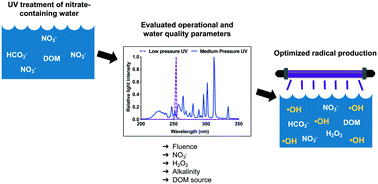Nitrate with benefits: optimizing radical production during UV water treatment†
Abstract
Nitrate is ubiquitous in natural and human impacted water systems. Irradiation of nitrate by UV light during water treatment can produce hydroxyl and other radicals (e.g., reactive nitrogen species) that react with and oxidize organic contaminants. The aim of this study was to investigate water quality and operational conditions that impact radical production during medium pressure UV (MPUV, 200–400 nm) and low pressure UV (LPUV, 254 nm) treatment of nitrate-containing waters. Because the behavior of nitrate has been shown to be influenced by its concentration and the presence of hydrogen peroxide and alkalinity during UV photolysis, these parameters were systematically evaluated for their effect on the generation of radicals and formation of nitrite. Bench-scale experiments used para-chlorobenzoic acid to indirectly measure radicals formed in UV/NO3− systems. Analysis using a central composite design revealed a synergistic effect between nitrate and alkalinity. Optimal conditions for radical production during LPUV were found to shift from low to high nitrate concentration as alkalinity was increased. The role of nitrite and its formation in diverse water matrices during UV exposure was assessed at high UV fluence levels (up to 4000 mJ cm−2) that are often used in remediation of contaminated waters. Radical production during MPUV/NO3− became increasingly higher than LPUV/NO3− as the ratio of nitrate to hydrogen peroxide concentration was increased. However, the efficacy of MPUV decreased as fluence was increased (>1000 mJ cm−2) due to formation of nitrite which scavenged hydroxyl radicals.



 Please wait while we load your content...
Please wait while we load your content...